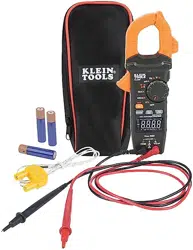Loading ...
Loading ...
Loading ...

4 5
OTHER MEASUREMENT APPLICATIONS
Maximum Input: 600V AC RMS or 600V DC
• Diode Test: Approx. 1mA, open circuit voltage ~3.0V DC
• Continuity Check: Audible signal <10Ω, max current 1.5mA
• Sampling Frequency: 3 samples per second
• Auto Power off: After ~5 minutes of inactivity.
• Over Limit: "OL" indicated on display
• Polarity: "-" on display indicates negative polarity
• Display: 3-3/4 digit, 4000 Count LCD
ELECTRICAL SPECIFICATIONS
Function Range Resolution Accuracy
Capacitance
40.00nF 0.01nF ±(4% + 25 digits)
400.0nF 0.1nF
±(4% + 8 digits)
4.000μF 0.001μF
40.00μF 0.01μF
400.0μF 0.1μF
4.000mF 0.001mF ±(5% + 9 digits)
Maximum Input: 600V AC RMS or 600V DC
Temperature
°F
-40° to 10°F
1
°F
±(1.2% + 7 digits)
11° to 1832°F
±(1.2% + 6 digits)
Temperature
°C
-40° to -12°C
1
°C
±(1.2% + 4 digits)
-11° to 1000°C
±(1.2% + 3 digits)
Maximum Input: 600V AC RMS or 600V DC
Frequency
10Hz to
60kHz
0.001Hz
to 0.01kHz
±(0.1% + 5 digits)
Duty Cycle
0.1% to 99.9%
≤1000kHz
0.1%
±1.5%
(Range: 10% – 90%)
Maximum Input: 600V AC RMS or 600V DC
Voltage Range: 8V to 240V AC RMS
Pulse Width: >0.1ms, must be zero-crossing signal.
ENGLISH
WARNINGS - GENERAL
• Never use the meter on a circuit with voltages that exceed the category
based rating of this meter.
• Do not use the meter during electrical storms or in wet weather.
• Do not use the meter or test leads if they appear to be damaged.
• Use only with CAT III or CAT IV rated test leads.
• Ensure test leads are fully seated into jacks, and keep fingers away from
the metal probe contacts when making measurements.
• Use caution when working with voltages above 25V AC RMS or 60V DC.
Such voltages pose a shock hazard.
• To avoid false readings that can lead to electrical shock, replace batteries
when a low battery indicator appears.
• Do not attempt to measure resistance or continuity on a live circuit.
• Always adhere to local and national safety codes. Use personal protective
equipment to prevent shock and arc blast injury where hazardous live
conductors are exposed.
• To avoid risk of electric shock, disconnect leads from any voltage source
before removing battery door.
• To avoid risk of electric shock, do not operate meter while battery door
is removed
WARNINGS
To ensure safe operation and service of the meter, follow these
instructions. Failure to observe these warnings can result in
severe injury or death.
• Before each use verify meter operation by measuring a known
voltage or current.
WARNINGS - NCV FUNCTION
• When NCV Function is initiated, a blinking or steady red glow and an audible
beep indicate voltage present. If no indication, voltage could still be present.
• Before and after each use of the NCVT, verify operation by testing a known
working circuit that is within the rating of this unit.
• Never assume neutral or ground wires are de-energized. Neutrals in multi-wire
branch circuits may be energized when disconnected and must be retested
before handling.
• The NCV tester WILL NOT detect voltage if:
• The wire is shielded.
• The
operator is not grounded or is otherwise isolated from an effective earth ground.
• The voltage is DC.
• The NCV tester MAY NOT detect voltage if:
• The user is not holding the tester.
• The user is insulated from the tester with a glove or other materials.
• The wire is partially buried or in a grounded metal conduit.
• The tester is at a distance from the voltage source.
• The field created by the voltage source is blocked, dampened, or otherwise
interfered with.
• The frequency of the voltage is not a perfect sine wave between 50 and 500Hz.
• The tester is outside of operation conditions (listed in Specifications section).
• Operation may be affected by differences in socket design and insulation
thickness and type; tester may not be compatible with some types of standard
or tamper resistant (TR) electrical outlets.
• Do not apply to uninsulated hazardous live conductors.
• Detection above 50V is specified under “normal” conditions as specified below.
The tester may detect at a different threshold at different conditions, or may not
detect at all unless:
• The
tip of the tester is within 0.25" of an AC voltage source radiating unimpeded.
• The user is holding the body of the tester with his or her bare hand.
• The user is standing on or connected to earth ground.
• The air humidity is nominal (50% relative humidity).
• The tester is held still.
Loading ...
Loading ...
Loading ...
